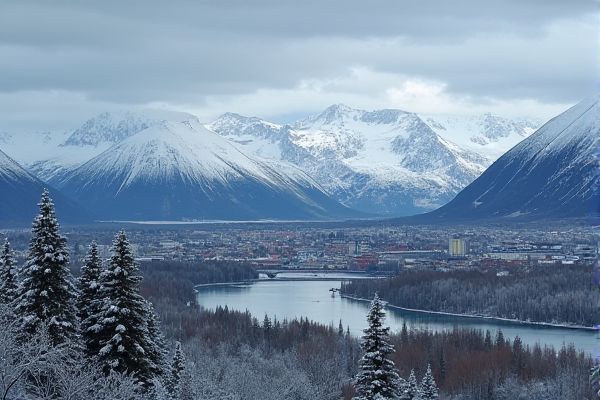
Weather and climate in Alaska: Long, cold winters and short, mild summers. Extreme temperature variations between regions. Frequent snow and ice conditions. Limited daylight in winter, endless daylight in summer. Northern Lights visible during winter months. Coastal areas experience milder climates. Interior regions endure harsh temperature extremes. Rainforest climate in Southeast Alaska. Diverse wildlife adapted to cold environments. Be prepared for sudden weather changes.
Long, cold winters and short, mild summers.
Alaska's climate is characterized by long, cold winters and short, mild summers, with significant variations between its interior and Arctic regions. The interior experiences winter temperatures ranging from about 20 to -10 degrees Fahrenheit (-7 to -23 degrees Celsius), while summer brings milder weather with temperatures from 45 to 75 degrees Fahrenheit (7 to 24 degrees Celsius). Meanwhile, the Arctic coastal lowlands experience harsher winter conditions with temperatures ranging from about -5 to -20 degrees Fahrenheit (-21 to -29 degrees Celsius) and slightly cooler summers with temperatures between 35 and 55 degrees Fahrenheit (2 to 13 degrees Celsius). Explore more about the intricacies of Alaska's Climate on Britannica to gain a comprehensive understanding of this diverse state's weather patterns.
Extreme temperature variations between regions.
Alaska exhibits extreme temperature variations across its regions, with the interior experiencing temperatures ranging from the 90s °F (34 °C) in summer to below -50 °F (-45.6 °C) or even -60 °F (-51.1 °C) in winter, while the Arctic north has long, cold winters and short, cool summers with temperatures rarely above freezing. The southern coastal areas have more moderate temperatures ranging from 40 to 60 °F (4 to 16 °C) in summer and 20 to 40 °F (-7 to 4 °C) in winter. For more detailed information about these climatic conditions, visit the Climate of Alaska page.
Frequent snow and ice conditions.
Alaska's snow and ice conditions are being thoroughly monitored as part of the Fresh Eyes on Ice program. This innovative initiative employs snowmachine journeys, drone surveys, satellite imagery, and citizen science to ensure safer travel on lakes and rivers during critical times such as freeze-up, winter, and breakup. The program receives vital support from prominent organizations, including the National Science Foundation and NASA. As Alaska and Changing Climate outlines, the region is experiencing significant alterations due to climate change, with a shortened snow-cover season, earlier river ice breakup, and diminished ice coverage. These changes have profound effects on rural transportation, infrastructure, and community activities crucial for the local way of life, such as hunting and fishing.
Limited daylight in winter, endless daylight in summer.
In Alaska, winters are characterized by limited daylight, with Anchorage receiving nearly 5.5 hours of daylight on the shortest day, while summers offer extended daylight, with up to 22 hours of functional daylight around the summer solstice, particularly in regions like Anchorage and the far north. For more details about these unique daylight patterns, visit the Hours Of Daylight page on the Anchorage website, which provides comprehensive insights on planning your trip according to the season's light conditions.
Northern Lights visible during winter months.
The best time to see the Northern Lights in Alaska is from mid-September to early April, when the nights are long and dark, with the winter months (November to March) offering the highest chances due to clearer skies and longer periods of darkness. For comprehensive guidance on planning your adventure, you can explore the detailed insights available on the Alaska Northern Lights website.
Coastal areas experience milder climates.
Coastal areas in Alaska experience milder climates due to the moderating influence of the ocean, resulting in warmer winters and cooler summers, as well as smaller diurnal temperature ranges. This maritime influence is particularly noticeable when the seas are ice-free, contrasting with the continental climate experienced in inland areas. For more detailed information and insights, you can visit the Alaska Climate website.
Interior regions endure harsh temperature extremes.
The interior regions of Alaska endure harsh temperature extremes, with summer temperatures sometimes reaching into the 90s °F and winter temperatures dropping as low as -60 °F, and the area has recorded both the highest and lowest temperatures in Alaska. This includes a high of 100 °F at Fort Yukon and a low of -80 °F at Prospect Creek. For more detailed information on Alaska's unique climate patterns, check out the State Summaries.
Rainforest climate in Southeast Alaska.
Southeast Alaska, particularly around Juneau, is characterized by a temperate rainforest climate with cool temperatures and high precipitation, receiving about 90 inches of rain annually. This lush and diverse region experiences rain or snow on 236 days per year, influenced by the collision of cold wind and warm ocean currents. This unique climate creates a vibrant ecosystem, supported by conditions typical of the Pacific Rainforest. To learn more about the fascinating characteristics of this region, visit the detailed exploration on the Climate and Habitats of the Pacific Rainforest page.
Diverse wildlife adapted to cold environments.
Alaska's diverse wildlife, such as Caribou, are highly adapted to cold environments with specialized coats, seasonal physiological changes, and migratory behaviors, though they face increasing challenges from climate change, including warmer winters and ice formation on snow that hampers their access to essential food sources. Discover more about how these animals adapt and thrive by visiting the U.S. Fish and Wildlife Service website.
Be prepared for sudden weather changes.
Alaska is experiencing rapid climate change, leading to sudden and extreme weather events such as earlier snowmelt, increased precipitation falling as rain, severe storms, flooding, and wildfires. Residents should be prepared for variable precipitation patterns, earlier river ice breakup, and more frequent extreme weather events like heavy rains and landslides. For more information on these crucial changes, you can explore the insights provided on the U.S. Climate Hubs website. These changes signify the urgency for preparedness and adaptation in the face of an evolving climate system.
